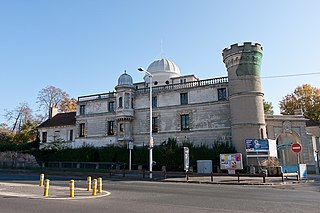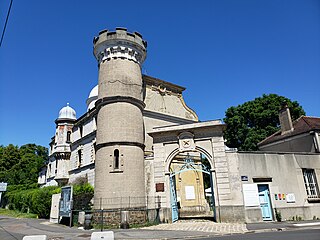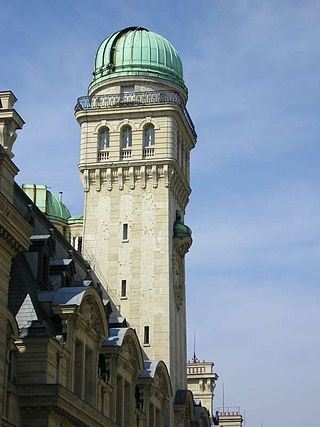
Eugène Michel Antoniadi was a Greek-French astronomer.
Bernard Ferdinand Lyot was a French astronomer.

Nicolas Camille Flammarion FRAS was a French astronomer and author. He was a prolific author of more than fifty titles, including popular science works about astronomy, several notable early science fiction novels, and works on psychical research and related topics. He also published the magazine L'Astronomie, starting in 1882. He maintained a private observatory at Juvisy-sur-Orge, France.

Juvisy-sur-Orge is a commune in the Essonne department in Île-de-France in northern France. It is located 18 km south-east of Paris, a few kilometres south of Orly Airport.

Markree Observatory was an astronomical observatory in County Sligo, Ireland. The asteroid 9 Metis was discovered from this observatory in 1848 by Cooper's assistant Andrew Graham using a comet seeker telescope. The observatory was also home to the largest refractor of the early 1830s, which had a 13.3-inch (340 mm) aperture Cauchoix of Paris lens; the largest in the world at that time. The observatory also housed a number of instruments and was operated to varying degrees throughout the 19th century.

Ferdinand Jules Quénisset (1872–1951) was a French astronomer who specialized in astrophotography.
Gabrielle Renaudot Flammarion was a French astronomer. She worked at the Camille Flammarion Observatory at Juvisy-sur-Orge, France, and was General Secretary of the Société Astronomique de France.

Great refractor refers to a large telescope with a lens, usually the largest refractor at an observatory with an equatorial mount. The preeminence and success of this style in observational astronomy defines an era in modern telescopy in the 19th and early 20th century. Great refractors were large refracting telescopes using achromatic lenses. They were often the largest in the world, or largest in a region. Despite typical designs having smaller apertures than reflectors, great refractors offered a number of advantages and were popular for astronomy. It was also popular to exhibit large refractors at international exhibits, and examples of this include the Trophy Telescope at the 1851 Great Exhibition, and the Yerkes Great Refractor at the 1893 World's Fair in Chicago.

The Société astronomique de France, the French astronomical society, is a non-profit association in the public interest organized under French law. Founded by astronomer Camille Flammarion in 1887, its purpose is to promote the development and practice of astronomy.

The Prix Jules Janssen is the highest award of the Société astronomique de France (SAF), the French astronomical society.
Alfred-Henri Recoura or Alfred Recoura, was a French architect.

L'Astronomie is a monthly astronomy magazine published by the Société astronomique de France (SAF). Sylvain Bouley, the president of SAF, is the publication director and astronomer Fabrice Mottez is the editor-in-chief.

The observatory was established in Juvisy-sur-Orge in 1883 by the French astronomer and author Camille Flammarion. In March 2010, the structure was classified as a historical monument by the French Ministry of Culture. The observatory belongs to the Société astronomique de France.

The Astronomy Tower of the Sorbonne is a tower at the Sorbonne University's Paris campus built to house an astronomical observatory for its students. The structure was erected during the reconstruction of the Sorbonne, between 1885 and 1901. The tower is 39 meters high, has an upper and lower dome, and includes several rooms. The upper dome houses the telescope, and the lower dome contains an optics workshop for amateurs to make mirrors. The tower is operated by the Société astronomique de France and is available for tours and amateur observations.
Raymond Augustin Jean-Baptiste Mailhat was a French manufacturer of telescopes and precision optical instruments.

The Observatory of the rue Serpente was an astronomical observatory owned and operated by the Société Astronomique de France in the historic Latin Quarter of Paris. It operated between 1890 until 1968, when it was transferred to a new location at the nearby Astronomy Tower of the Sorbonne.

Secretan was a company based in Paris, France that manufactured telescopes and other scientific instruments.

Arago telescope is a 38 cm aperture refracting telescope at Paris Observatory, installed in 1857. Francois Arago ordered this telescope from the telescope making firm Lebreours in 1839, and after a protracted development was completed by 1855. The name Lunette Arago is a modern name for the telescope, and other large refractor of Paris observatory, is the one at Meudon. It has gone by a variety of names having to do with various aspects of the telescope, such as its aperture, or location on the East tower of the Paris observatory, or its equatorial mount made by Brunner. In one journal report it was called the 'east equatorial' for example, in another instance '38 cm refractor'. In French language it has been called the La lunette équatoriale de 38 cm de l'Observatoire de Paris.

Sylvie Pétiaux was a French feminist and pacifist. She was the wife of the astronomer, Camille Flammarion, and collaborator with him in much of his astronomical work. She was a Prix Jules Janssen laureate in 1902.
















